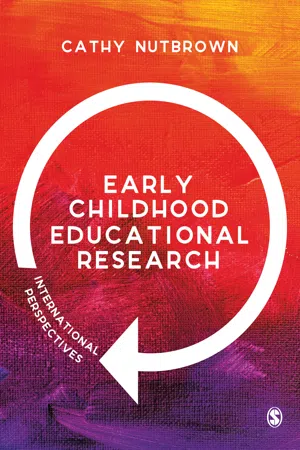
- 312 pages
- English
- ePUB (mobile friendly)
- Available on iOS & Android
About This Book
Early Childhood educational research is a constantly evolving field. This book brings together Cathy Nutbrown's considerable knowledge and expertise in the field, to deliver a comprehensive and critical overview of national and international research. The strengths of various types of research, and their influence on theory, policy and practice, are identified along with new and emerging research areas, and anticipated future topics and patterns of research.
Through an analytical discussion of research topics addressing Children, Adults and Pedagogy, these key areas are highlighted:
- Issues in research design
- Types of and trends in methodological approaches
- The ethics of research
With digestible chapter introductions, thinking points and suggestions for research or dissertation topics, readers are also able to locate their own work in an international landscape. This is the perfect 'go to' resource for all early childhood education and social science researchers. Cathy Nutbrown will be discussing ideas from Early Childhood Educational Research in Doing Your Early Years Research Project, a SAGE Masterclass for early years students and practitioners in collaboration with Kathy Brodie.
Frequently asked questions
Information
1 Research Threads: Weaving Understandings of Early Childhood Education from the 20th Century
- young children’s learning
- parents’ roles
- children’s rights
- assessment
- early literacy
- inclusion
- the arts
- history.
Young Children’s Learning
Young children are imaginative and capable learners; curricula should match their developmental needs and their patterns of learning.
‘A three year old sits on the edge of a river bank. Her toes just touching the gently flowing water. She watches the insects skimming the surface, stares intently at a tiny fish which swims near to her feet. For some twenty minutes this little girl observes patiently. No one knows what she is thinking, but there is no doubt that her diligent study of the environment around her is something which takes up the whole of her being. No one tells her to study the water and the wildlife around her, no one asks her to sits still, to be quiet and to watch. Her interest is fuelled by a natural and instinctive curiosity about the world around her. (Nutbrown, 2011: 3).John was walking to school with his father. ‘If there’s woodwork today … if there’s the woodwork things … if there is I’m gonna, I’m gonna do my plane. I’m gonna finish the nailing and put on the wings – then I think I can paint it.’John’s father asked, ‘Have you got much to do to it?’John replied, ‘Could be a morning’s work there.’At four years old John was able to think about what he had done yesterday and plan what he wanted to do in his early years centre that morning. It depended, he knew, on what provision was available that day – on whether the adults made the woodworking bench and tools available as they had done the day before. John’s plan was to follow through on something he began the day before, he had plans for how to complete his model plane and was thinking about how long it might take him. He was being consistent, planning his progress through a self-chosen task. What he needed was the right provision – the available equipment and space to enable him to see his plans through. (Nutbrown, 2011: 28) ’
Parents’ Roles in their Children’s Learning
For all our efforts and professionalism, it is parents and families that are the primary and major educators.
Table of contents
- Cover
- Half Title
- Publisher Note
- Title Page
- Copyright Page
- Contents
- Illustration List
- Table List
- About the Author
- Preface
- Acknowledgements
- 1 Research Threads: Weaving Understandings of Early Childhood Education from the 20th Century
- Part I Children
- 2 Children’s Rights and Early Childhood Education and Care
- 3 Young Children’s Well-Being and Spirituality
- 4 Play in Early Childhood Education and Care
- 5 Children as Participants in Their Own Learning and in Research
- 6 Poverty in Childhood and the Impact of Early Childhood Education and Care
- Reflection on Part I Research Focusing on Children
- Part II Adults
- 7 Parents and Early Childhood Education and Care
- 8 Inclusion and Diversity in Early Childhood Education and Care
- 9 Multi-Professional and Inter-Disciplinary Working in Early Childhood Education and Care
- 10 Professionalism, Qualifications and Status
- 11 Leadership in Early Childhood Education and Care
- 12 Ethics of Work with Young Children in Early Childhood Education and Care
- Reflection on Part II Research Focusing on Adults
- Part III Learning and Teaching
- 13 Curricular Approaches: Pedagogy and Practice in Early Childhood Education and Care
- 14 Early Literacy Development and Learning
- 15 Languages and Early Learning
- 16 Digital Technologies and Early Childhood Education and Care
- 17 Assessment in Early Childhood Education and Care
- Reflection on Part III Research Focusing on Learning and Teaching
- 18 Research in Early Childhood Education in the 21st Century: Salience, Significance and Challenge
- Author Index
- Index